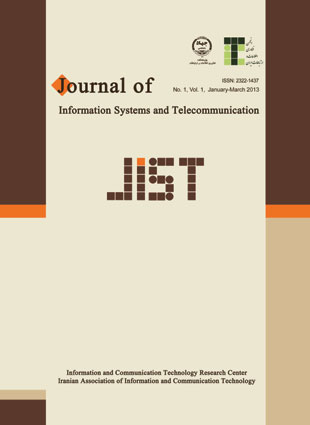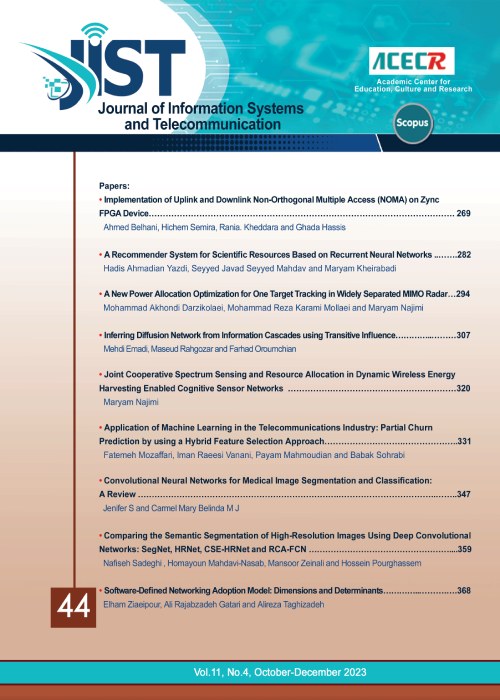فهرست مطالب

Journal of Information Systems and Telecommunication
Volume:1 Issue: 1, Jan-Mar 2013
- تاریخ انتشار: 1392/02/04
- تعداد عناوین: 7
-
-
Page 1In this paper, by using a simple mathematical inequality, we derive a$ new upper bound fkr the capacity of$ free space optical channel in coherent case. Then, by applying general fading distribution, we obtain an upper bound for mutual information in non-coherent case. Finally, we derive the corresponding optimal input distributions for both coherent and non-coherent cases, compare the results with previous works numerically and illustrate that our results subsume some of previous results in special cases.
-
Page 9Effective algorithms in modern digital communication systems provide a fundamental basis forincreasing the efficiency of the application networks which are in many cases neither optimized nor very close to their practical limits. Equalizations are one of the preferred methods for increasing the efficiency of application systems such as orthogonal frequency division multiplexing (OFDM). In this paper, we study the possibility of improving the OFDM modulation employing sliced multi-modulus algorithm (S-MMA) equalization. We compare applying the least mean square (LMS), multi modulus algorithm (MMA) and S-MMA equalizations to the per tone equalization in the OFDM modulation. The paper contribution lies in using the S-MMA technique, for weight adaptation, to decreasing the BER in the OFDM multicarrier modulation. For more efficiency, it is assumed that the channel impulse response is longer than the cyclic prefix (CP) length and as a result, the system will be more efficient but at the expense of the high intersymbol interference (ISI) impairment existing. Both analysis and simulations demonstrate better performance of the S-MMA compared to LMS and MMA algorithms, in standard channels with additive white Gaussian noise (AWGN) and ISI impairment simultanously. Therefore, the S-MMA equalization is a good choice for high speed and real-time applications such as OFDM based systems.Keywords: Cyclic Prefix, Equalization, ISI, LMS, MMA, OFDM, SMMA
-
Page 19In current air traffic control system and especially in free flight method, the resolution of conflicts between different aircrafts is a critical problem. In recent years, conflict detection and resolution problem has been an active and hot research topic in the aviation industry. In this paper, we mapped the aircrafts’ conflict resolution process to graph coloring problem, then we used a prioritization method to solve this problem. Valid and optimal solutions for corresponding graph are equivalent to free conflict flight plans for aircrafts in airspace. The proposed prioritization method is based on some score allocation metrics. After score allocation process, how much the score of an aircraft be higher its priority will be higher and vice versa how much the score of an aircraft be lower its priority will be lower. We implemented and tested our proposed method by different test cases and test results indicate high efficiency of this method.Keywords: Air Traffic Control, Free Flight, Conflict Detection, Resolution, Graph Coloring Problem, Prioritization Method
-
Page 27In the present paper, a basic proof method is provided for representing the verification, Validation and evaluation of expert systems. The result provides an overview of the basic method for formal proof such as: partition larger systems into small systems prove correctness on small systems by non-recursive means, prove that the correctness of all subsystems implies the correctness of the entire system.Keywords: Expert System, Partition, Non, recursive
-
Page 33The dependability of concurrent programs is usually limited by concurrency errors like deadlocks and data races in allocation of resources. Deadlocks are difficult to find during the program testing because they happen under very specific thread or process scheduling and environmental conditions. In this study, we extended our previous approach for online potential deadlock detection in resources allocated by multithread programs. Our approach is based on reasoning about deadlock possibility using the prediction of future behavior of threads. Due to the nondeterministic nature, future behavior of multithread programs, in most of cases, cannot be easily specified. Before the prediction, the behavior of threads should be translated into a predictable format. Time series is our choice to this conversion because many Statistical and Artificial Intelligence techniques can be developed to predict the future members of the time series. Among all the prediction techniques, artificial neural networks showed applicable performance and flexibility in predicting complex behavioral patterns which are the most usual cases in real world applications. Our model focuses on the multithread programs which use locks to allocate resources. The proposed model was used to deadlock prediction in resources allocated by multithread Java programs and the results were evaluated.Keywords: Detecting potential deadlocks, time series prediction, multithread programs, behavior extraction
-
Page 47Process migration is critical to dynamic balancing of workloads on cluster nodes in any high performance computing cluster to achieve high overall throughput and performance. Most existing process migration mechanisms are however unsuccessful in achieving this goal proper because they either allow once-only migration of processes or have complex implementations of address space transfer that degrade process migration performance. We propose a new process migration mechanism for HPC clusters that allows multiple migrations of each process by using the network RAM feature of clusters to transfer the address spaces of processes upon their multiple migrations. We show experimentally that the superiority of our proposed mechanism in attaining higher performance compared to existing comparable mechanisms is due to effective management of residual data dependencies.Keywords: High Performance Computing (HPC) Clusters, Process Migration, Network RAM, Load Balancing, Address Space Transfer
-
Page 55Smart and timely detection of fire can be very useful in coping with this phenomenon and its inhibition. Enhancing some image analysis methods such as converting RGB image to HSV image, smart selecting the threshold in fire separation, Gaussian mixture model, forming polygon the enclosed area resulted from edge detection and its combination with original image, this papers addresses fire detection. Accuracy and precision in performance and rapid detection of fire are among the features that distinguish this proposed system from similar fire detection systems such as Markov model, GM, DBFIR and other algorithms introduced in valid articles. The average accuracy (95%) resulted from testing 35000 frames in different fire environments and the high sensitivity (96%) was quite significant. This system be regarded as a reliable suitable alternative for the sensory set used in residential areas, but also the high speed image processing and accurate detection of fire in wide areas makes it low cost, reliable and appropriate.Keywords: Fire detection, Gaussian Mixture Model, image processing, HSV Space, edge detection


